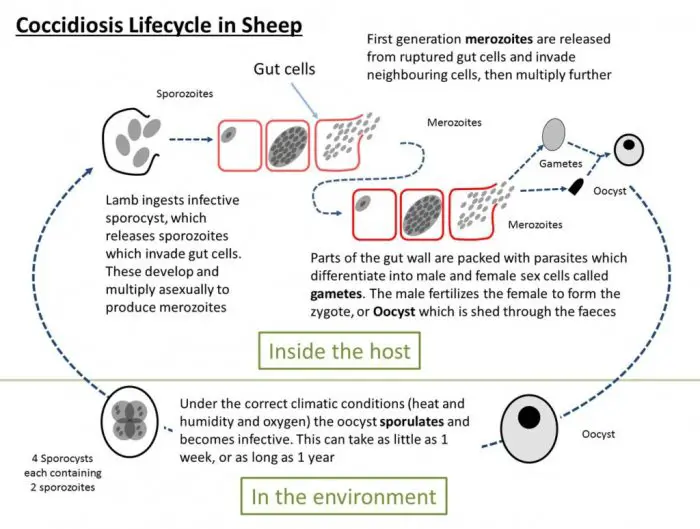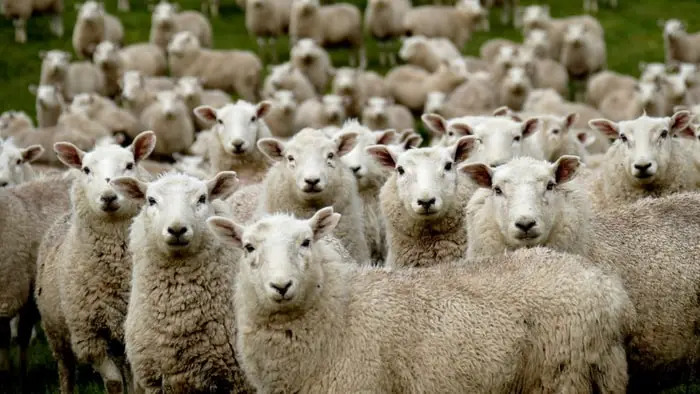Coccidiosis in sheep is one of the essential protozoal diseases caused by Eimeria spp and is characterized by bloody diarrhea. Coccidiosis is found in all age groups of sheep bu most common in young lambs ages ranging from 3-8 weeks and peaking during 5-6 weeks. The disease is more common in the intensive rearing system of sheep.
Importance of Coccidiosis in Sheep
Lamb coccidiosis is one of the most common diseases in sheep farms. The disease is primarily seen in young lambs aged 5-8 weeks. The disease is caused by the single-celled protozoan species Eimeria. The disease is resistant in older sheep, but they act as reservoirs.
Causes of Lamb Coccidiosis
Lamb coccidiosis is caused by protozoal species Eimeria. The Eimeria is host specific, and the species that caused disease in cattle cannot affect sheep or goats. The most common species of protozoa that cause disease in sheep are Eimeria ovinoidalis and Eimeria crandallis. Eimeria ovina is comparatively less pathogenic than the other two species. The older sheep are reservoirs of the infection and spread to young lamb kids.

Risk Factors of Coccidiosis in Sheep
The disease is not equally important in the age groups of sheep. The risk factors of the disease are as follows:
- Overcrowded housing.
- Young lambs, especially 5-6 weeks of age when they start eating grass.
Pathogenesis of Lamb Coccidiosis
Eimeria is single-celled protozoa that complete its life cycle on a single host.
- The older sheep are reservoirs of organisms that spread oocyst through feces and urine to the environment.
- The young lamb gets the infection through the ingestion of contaminated grass.
- Oocyst rapidly multiplies in the gut cell and transforms into merozoites.
- The cell breakdowns and releases hundreds of merozoites that invade new gut cells.
- Within 7-14 days, the parasite increases a millionfold and converts male and female merozoites.
- The oocyst forms and passes through feces.

Clinical Signs of Coccidiosis in Sheep
The most common and easily identifiable clinical signs are as follows:
- Diarrhea
- Presence of mucous and blood in feces.
- Dehydration.
- Weakness.
- Excessive straining.
- Abdominal pain.
- Weight loss.
- Anemia.
- Wool breakdown.
- Tail and hindquarters soiled with feces.
- Death.
The upper cecum and ileum are primarily affected and found a petechial hemorrhage.
Diagnosis of Lamb Coccidiosis
The disease can be diagnosed by bloody diarrhea, weakness, and weakness. The following tests must confirm the disease:
- Examination of feces for oocyst.
- Post-mortem examination for inflammation of gut walls, erosions, bleeding, and discoloration.
- Examination of mucous membrane for anemia and dehydration.
- Complete blood test for hemoconcentration.
Treatment of Coccidiosis in Sheep
Three specific medicines are available for coccidiosis treatment: toltrazuril, diclazuril, and decoquinate.
- A dose of toltrazuril @ 20 mg per kg body weight reduces oocyst concentration.
- Diclazuril @ 1mg per kg body weight is the effective anticoccidial treatment for labs at age 5-6 weeks, and give the second dose at 7-8 weeks.
- You can give Sulphaquinoxole @ 0.015% in drinking water for 3-5 days in affected lambs.
- Fluid therapy.
- Vitamin mineral supplement to weak lambs.
Prevention and Control of Lamb Coccidiosis
There are two basic methods of prevention of coccidiosis; reduce the infected oocyst in the pasture, improve biosecurity, and reduce contamination. The second method is timed and targets the preventive treatment.
- Make a separate room for newborn lambs.
- Clean the house, feed through, and supply pure drinking water.
- Maintain low stocking density.
- Rotation of pastures.
- Treat pastures with antiparasitic medications.
- Separate affected sheep from healthy animals, especially from lambs.
- Provide clean beddings to young lambs.
Concluding Remarks on Coccidiosis in Sheep
Coccidiosis in sheep is one of the most economic diseases. The disease causes considerable economic loss on sheep farms by the death of lambs, reduced production, increased cost due to treatment and management, and labor costs. In my article, I have discussed most of the crucial aspects of the disease. You can quickly reduce the incidence of the disease by taking adequate preventive measures.